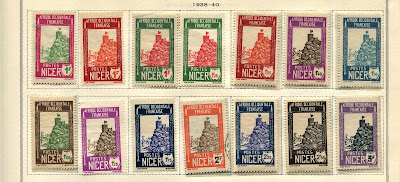Jules Ferry, a
French politician, had declared at the outset of the European scramble for
Africa, "The higher races have a right over the lower races, they have a
duty to civilize the inferior races." West African annoyances blew the lid
off such cruel, ill-logical and deceptive claims.
Nevertheless,
France tried to manage its colonial headaches by redrawing administrative
frontiers and changing colony names – hoping to strengthen its control. Niger
provides a case in point. In 1899 French Sudan split up and part of it was
renamed Upper Senegal and Middle Niger (Haut-Sénégal et Moyen Niger).
The name changed in 1902 to Senegambia and Niger (Sénégambie et Niger)
and it stayed that way just long enough for a few stamps to be issued. Then the name changed again (1904) to Upper
Senegal and Niger (Haut-Sénégal et Niger); new stamps were printed. Less
than a decade later Niger became a separate military district (1911), although
on maps and in stamp albums it was still considered a part of Upper Senegal and
Niger.
Finally,
in 1922, Niger became a separate colony with civilian administrators and, yet
again, new stamps were issued, the first of which were the overprinted camel
and rider stamps of Haut-Sénégal et Niger. The Territoire du Niger
overprint typically blocks out the inscribed Haut-Sénégal et Niger. The
same series was also overprinted for the new French Sudan, which was the
remaining part of Haut-Sénégal et Niger.
Only four stamp
designs are unique to Niger: a water well, a boat on the Niger river, a
fortress, and a prostrate camel peering at a Timbuktu caravansary in the
distance (even though Timbuktu was no longer near the Niger border). Camels and
water were/are essential in Niger, and therefore apt selections for stamp
designs. Ever efficient in deserts, a typical camel can gulp down a beer keg of
water in less than a minute. When fully hydrated, it carries about 53 gallons
in its hump.
All other
classical era Niger stamps are French Colonial common designs.
Collectors who use
BB Part 2 will notice that Niger has no “France Libre” overprints. During World
War II, Niger was loyal to German dominated France and Marshal Pétain’s Vichy
government, while other colonies supported de Gaulle. “France Libre” appears
only on the stamps of colonies where de Gaulle was organizing resistance.
Census: 102 in BB space, 14 on the supplement page.
And that, perhaps ironically, is one of the attractions of WW classical stamp collecting.






















I love your blog. Thanks for your work.
ReplyDeleteThanks for saying so.
ReplyDeleteObrigado por compartilhar esses mapas. É tão difícil encontrar mapas modernos sobre essa época.
ReplyDelete"Thanks for sharing these maps. It's so hard to find modern maps about that era."
DeleteThanks Mario for the comment about the map. It is all due to Gerben van Gelder, who sadly passed away several years ago, but left this fantastic legacy.
Delete